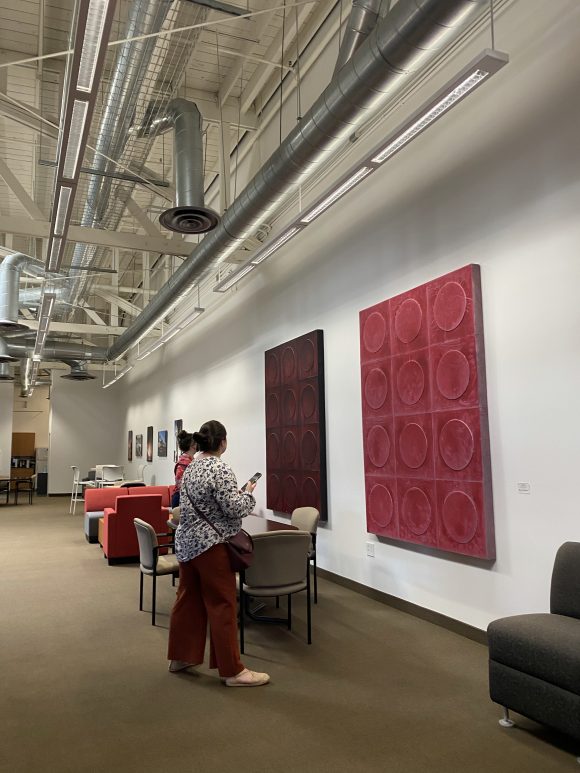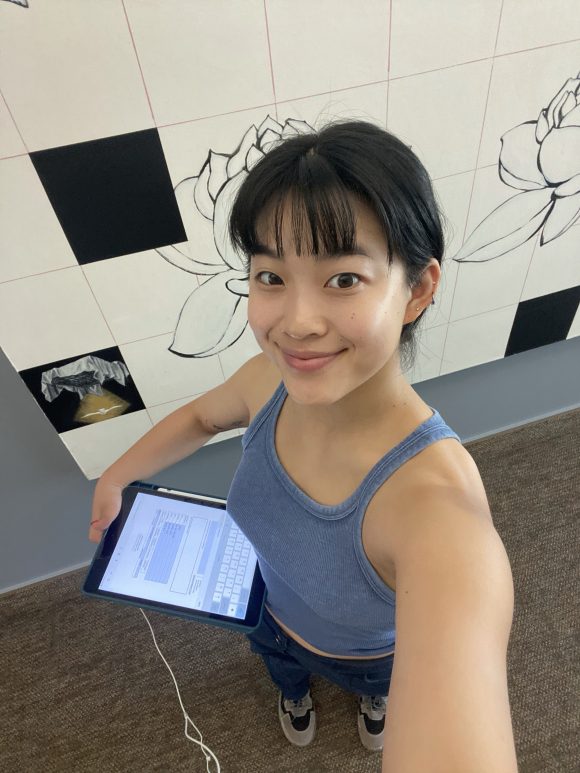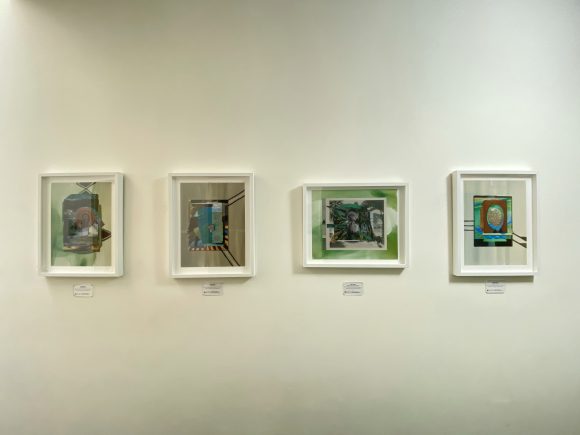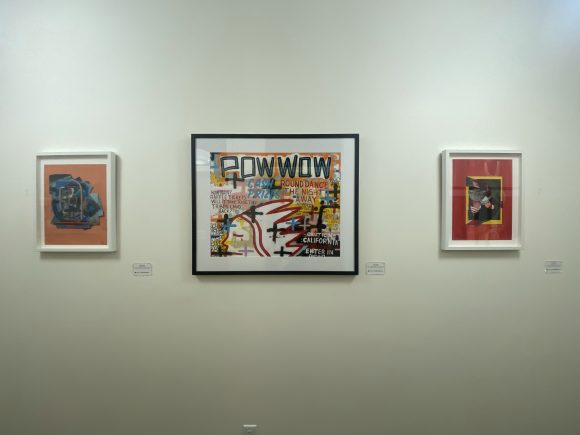An Escalette Summer From Urbana to Orange, From Intern to Marketing Assistant
October 4, 2022
This story begins in a little coffee shop in Urbana, Illinois, where I paired my first day as an intern at the Escalette Collection with a blackberry latte and a croissant. I opened Jessica’s e-mail attached with my official 10-week internship program. Seeing the program she curated just for me, I was filled with anticipation toward the 10 weeks of dipping my toes in various areas of museum work. This all began with Jessica Bocinski, Registrar of the Escalette Collection, giving my Art & Activism class a tour of the This Land is Your Land exhibition in Roosevelt Hall.
 I had recently discovered my passion for museums, especially art museums. I was taking a Museum Studies course and an Art & Activism course within my CCI (Creative and Cultural Industries) minor during that spring semester. Through these classes, I got multiple opportunities to interact with the Escalette Collection, including tours of their exhibitions and submitting Panther Perspectives. After my second tour with Jessica, I nervously approached her with questions about the collection. I was intrigued by the concept of a “museum without walls” that challenged the notion of what a museum could be. My summer was looking a little bland, so I wanted to add some spice by seeing more art. A summer internship with the Escalette Collection sounded perfect.
I had recently discovered my passion for museums, especially art museums. I was taking a Museum Studies course and an Art & Activism course within my CCI (Creative and Cultural Industries) minor during that spring semester. Through these classes, I got multiple opportunities to interact with the Escalette Collection, including tours of their exhibitions and submitting Panther Perspectives. After my second tour with Jessica, I nervously approached her with questions about the collection. I was intrigued by the concept of a “museum without walls” that challenged the notion of what a museum could be. My summer was looking a little bland, so I wanted to add some spice by seeing more art. A summer internship with the Escalette Collection sounded perfect.
Fast forward to June 13th, after many emails back and forth, I finally got to start my internship! However, I was working remotely. I was spending 3 weeks in Urbana with family, 2 hours ahead of Orange, starting this journey on my laptop. Week 1 was my introduction to Education and Public Outreach within museum work. The first mission Jessica gave me was to write a killer blog post about Mercedes Dorame, the Tongva artist behind
contemporary Californian landscape interventions. Writing had always been one of my hobbies, but I had never written about artists and their work before. This assignment was intimidating. After spending hours researching Mercedes Dorame, I thought I was done with the difficult part, but I was wrong. The difficult part was actually deciding on which information could be excluded from the blog because if I included every interesting
detail about the artist, the blog post would become a book.
During weeks 2 and 3, still remote in Urbana, Jessica threw me into Social Media and Marketing. As a borderline social media addict, I already knew that behind the scenes of the Escalette Collection’s Instagram was where I could provide the most help. I revamped parts of their Instagram profile as I planned and designed posts for the month of July. During the 2 weeks, my favorite project was creating promotions for the Escalette Collection’s podcast, The Artist is Present. Unlike Henry, the Escalette Collection’s OG student worker, I can’t say I’m a graphic designer. I proudly admit that the Canva premium account was one of the best investments we have made since I graduated from my summer intern title to student marketing assistant.
 On July 4th, I said goodbye to Urbana and made my way back to Orange. After a month of long distance, I finally got to see Jessica and the artwork in person! As I learned the process of accessioning artwork, Jessica gave me exclusive private tours of the Escalette Collection’s storage space. Getting the chance to see artwork before they get presented to the public is such a special part of museum work. I also learned to condition report during the month of July. Through condition reporting, I was able to spend time with artwork. Even in museum settings, I often feel rushed to move on from one piece of artwork to another. As I was condition reporting Bovey Lee’s Magic Lily series in Beckman Hall, the process forced me to get up close and personal with each artwork as I thoroughly examined them. Despite it being a tedious task, I learned to appreciate and enjoy condition reporting for allowing me to sit with each of the works long enough to discover something new.
On July 4th, I said goodbye to Urbana and made my way back to Orange. After a month of long distance, I finally got to see Jessica and the artwork in person! As I learned the process of accessioning artwork, Jessica gave me exclusive private tours of the Escalette Collection’s storage space. Getting the chance to see artwork before they get presented to the public is such a special part of museum work. I also learned to condition report during the month of July. Through condition reporting, I was able to spend time with artwork. Even in museum settings, I often feel rushed to move on from one piece of artwork to another. As I was condition reporting Bovey Lee’s Magic Lily series in Beckman Hall, the process forced me to get up close and personal with each artwork as I thoroughly examined them. Despite it being a tedious task, I learned to appreciate and enjoy condition reporting for allowing me to sit with each of the works long enough to discover something new.
July flew by and August arrived. I was excited about August because I finally got to begin the final project of my summer internship. Jessica gave me the opportunity to curate a mini exhibition, filling two walls in Roosevelt Hall with artwork. This summer, the Escalette Collection acquired amazing artwork from Indigenous artists River Garza and Katie Dorame. When curating the two walls of Roosevelt Hall, I had to consider not only how the work aesthetically filled the space, but also how the work reflected the home of Wilkinson College of Arts, Humanities, and Social Sciences. Garza and Dorame’s work fulfilled both of these conditions through their contemporary representation of Indigenous identity, joining elements of the past and present within their culture and community. Dr. Jennifer Keene, the Dean of Wilkinson College, requested for Garza’s work to be displayed on the wall next to her office. Upon selecting Pow wow round 2 by River Garza as the centerpiece, I was able to quickly finalize two walls that well represent Wilkinson College’s vibrant and inspiring mission.
- Installation on 2nd floor of Roosevelt Hall
- Installation in Dean’s Suite of Roosevelt Hall
After spending 10 weeks of my summer with the Escalette Collection, I did not want to leave. Fortunately, Jessica and Fiona were able to offer me a position on their team! I have made quite the full circle by starting my internship with a blog post and ending my internship with this blog post. Now, as the official Escalette Collection’s student marketing assistant, I have begun a new chapter in my Chapman experience! I look forward to seeing what will happen next in my journey with our museum without walls! For now, I am most excited about our 10+2 Anniversary Party, the party of the decade. It will be a night to remember!
We invite you to explore all the works in the Escalette Collection by visiting our eMuseum.
Wilkinson College of Arts, Humanities, and Social Sciences is the proud home of the Phyllis and Ross Escalette Permanent Collection of Art. The Escalette Collection exists to inspire critical thinking, foster interdisciplinary discovery, and strengthen bonds with the community. Beyond its role in curating art in public spaces, the Escalette is a learning laboratory that offers diverse opportunities for student and engagement and research, and involvement with the wider community. The collection is free and open to the public to view.




